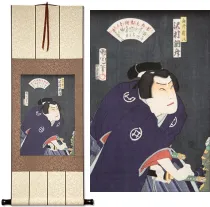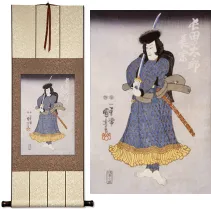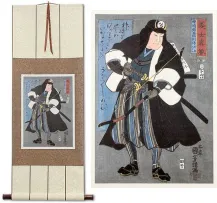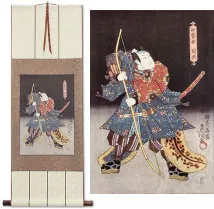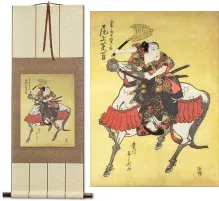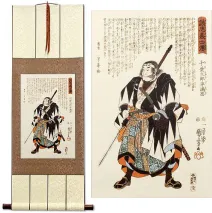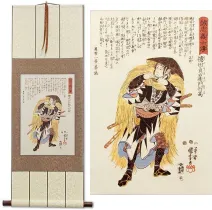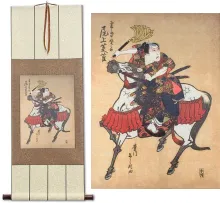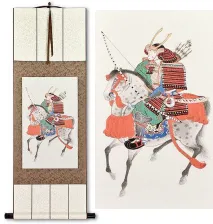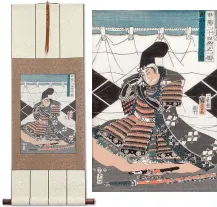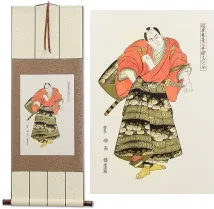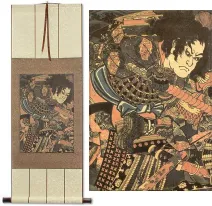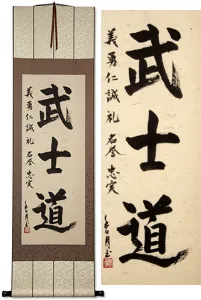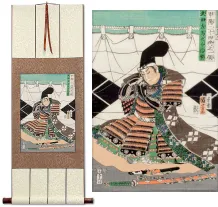Female Samurai Hangaku
Japanese Woodblock
Wall Scroll
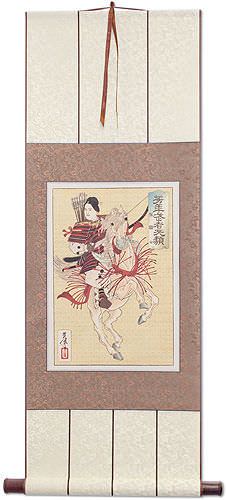

40½"
18¼"
• Delivered to you in Columbus by Dec 19th.
• Standard shipping is just $3.80 for any order.
• 3 in stock now. Future supply uncertain.
• Handmade Wall Scroll.
• Money-Back Guarantee.

This artwork will look great in your home or office.
Approximate Measurements
Artwork Panel: 28.4cm x 40.5cm ≈ 11¼" x 16"
Silk/Brocade: 37.5cm x 103.2cm ≈ 14¾" x 40½"
Width at Wooden Knobs: 46.5cm ≈ 18¼"
Information about caring for your wall scrollSee Larger Image






Hangakujo
The Female Samurai Hangaku
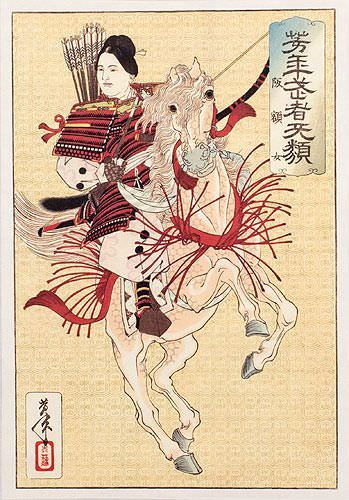
Close up view of the artwork mounted to this silk brocade wall scroll
This is a mechanically-printed reproduction of a very old Japanese woodblock print. This was made months ago, rather than centuries ago.
Original artist: Taiso, Yoshitoshi (1839-1892)
Original woodblock was created in Japan, around 1885
Excerpt from Wikipedia about Hangaku-Jō:
The Jō were warriors, allies of the Taira clan, in Echigo Province (present-day Niigata Prefecture). They were defeated in the Genpei Wars, and lost most of their power. In 1201, together with her nephew Jō Sukemori, she raised an army in response to Sukemoto's attempt (the Kennin Uprising) to overthrow the Kamakura Shogunate. Hangaku and Sukenaga took a defensive position at a fort at Torisakayama under attack from Sasaki Moritsuna. Hangaku commanded 3,000 soldiers to defend against an army of 10,000 soldiers loyal to the Hōjō clan.
Ultimately she was wounded by an arrow and captured; the defenses then collapsed. Hangaku was taken to Kamakura. When she was presented to the shogun Minamoto no Yoriie, she met Asari Yoshitō, a warrior of the Kai Genji, who received the shogun's permission to marry her. They lived in Kai, where she is said to have had one daughter.
About Real Japanese Woodblock Prints
Woodblock printing, often considered the precursor to the modern printing press, was first developed in China and later brought to Japan, where artists refined the technique into a unique art form. In Japan, these prints are called 木版畫 ("Moku Hanga"). Most were created during the Edo period (1603–1867), though production continued into the early 20th century.
Japanese artists would first create a "template painting" depicting scenes of daily life, including women washing clothes, men writing poetry, samurai battles, and occasionally more dramatic subjects. These template images, known as 浮世絵 (Ukiyo-e, or "Floating World"), were then carved into wood by skilled artisans. Another specialist applied wet ink or pigments to the carved blocks, and a sheet of handmade paper was pressed on to create the final print. This collaborative process produced vibrant, detailed artworks much faster than hand-painting hundreds of copies.
About This Reproduction
Original Japanese woodblock prints from the Edo period can sell for $800 to $20,000. Our prints are high-quality reproductions, crafted to capture the look and feel of the originals, though experts will recognize them as reproductions.
We use authentic handmade kozo (mulberry) paper—the same paper Japanese printmakers used centuries ago. Archival, UV-resistant pigment inks ensure long-lasting color, with laboratory testing showing up to 95 years of fade-free enjoyment if kept out of direct sunlight. Each reproduction is carefully color-corrected and restored, bringing the Edo period artwork to life for your wall.

Photographer Jeremy Cowart and the Canon imagePROGRAF PRO-2000 giclée printer used to create these reproductions.
Printing on delicate handmade paper is challenging. After testing multiple high-end printers, we found the Canon imagePROGRAF PRO-2000 delivers the precision and quality needed, using 12 archival inks and 18,432 nozzles. Each print is then sent to our Beijing workshop, where it is mounted into a handmade wall scroll, ready-to-hang without the need for expensive framing, giving your piece an authentic Japanese look.
Because the original artist has long passed, these works are public domain. In some cases, we license high-resolution scans of original prints, or even scan 200-year-old originals ourselves. This dedication ensures you receive a stunning Japanese woodblock print reproduction at an affordable price, making traditional Asian art accessible to everyone.
Want a custom wall scroll or unique print size? Just contact us!
We can print larger sizes, choose your preferred paper texture, and select silk brocade colors. Ready-to-frame prints can ship in days, while custom wall scrolls may take several weeks. Either way, the result is a truly one-of-a-kind piece of Japanese art.
This item was listed or modified
Jan 10th, 2023

